Accident Reports - August 2012
Mountain safety
Rockfall accident, Mount Geikie, Mount Robson Provincial Park, August 15 2012
Stranded Scramblers, Back of the Lake, Banff National Park, August 13, 2012
Lead Fall, East Ridge of Mt. Temple, Banff National Park, August 11, 2012
Fall on Snow, Mount Rogers, Glacier National Park, August 8, 2012
Broken Arm, Division Peak, Banff National Park; August 5, 2012
Rappelling accident, Castle Mountain, Banff National Park, August 4, 2012
Missing hiker, Saskatchewan Crossing, Banff National Park, August 1-2, 2012
Stranded Climbers, Tunnel Mountain, Banff National Park, August 2, 2012
Rockfall accident, Mount Geikie, Mount Robson Provincial Park, Aug 15 2012
On August 15th 2012, an experienced climbing party of four were climbing the S face of Mount Giekie. This is a remote alpine style rock climb located at the western portion of the Rampart Mountains in Tonquin Valley. The parties were climbing in 2 rope teams staying in close proximity to each other. At approximately 10a.m., one of the climbers was leading a 5.4 pitch when the 1/2 car size block he was standing on released causing him to fall along with it. Tumbling with the large rock, he fell 20m before his belayer caught him just as he hit a ledge with the large rock. The rock exploded spreading shrapnel. This ledge was adjacent to the second party. The belayer was hit by rock fall, injuring him and forcing him off the ledge. 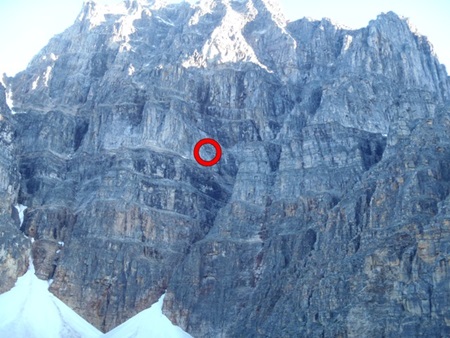
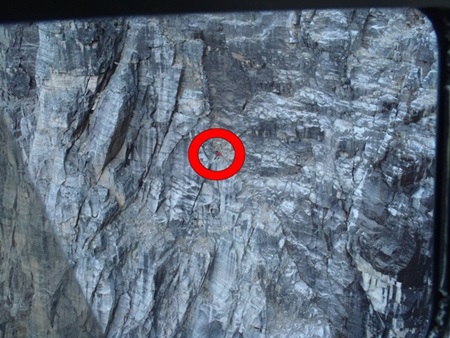
An overview and a closeup of the accident scene on Mt. Geikie
The belayer suffered 3 broken ribs. A third climber, who was standing near the ledge where the block impacted and where the lead climber came to rest, suffered lacerations to his head and soft tissue damage to his ankle with a hole in his boot from the rock. The fourth climber escaped unscathed. The lead climber suffered massive internal injuries, never regained consciousness, and eventually stopped breathing. They attempted to call out with a satellite phone but had no reception. Both climbing party’s ropes were damaged. They salvaged what they could and did short rappels to descend. The satellite phone was attempted several times during the descent with no reception.
They returned to base camp at 2050hrs and got satellite reception. They called Jasper National Parks Emergency dispatch to report the incident. It was dusk and a helicopter was launched from Yellowhead Helicopters in Valemount to fly directly to their camp. The helicopter had just enough daylight to retrieve one person and return to Valemount in the dark. Jasper National Parks rescue team helicoptered to the camp at first light. The remaining 2 people were evacuated and the lead climber was heli-slung off the face and pronounced deceased.
Analysis
This was an unfortunate rockfall accident to an experienced party. The victim was a long time Alpine Club of Canada member who had climbed all 11,000’ peaks in the Canadian Rockies. He likely fell as far as he did for a couple of reasons. The belayer was unable to catch the fall as he was hit by rocks, injured, and knocked off his ledge plus the victim likely had not put much protection in as he was on easier 5.4 climbing terrain.
Stranded Scramblers, Back of the Lake, Banff National Park, August 13, 2012
On Monday August 13th, a couple decided to go for a hike in the Lake Louise area. They walked the lakeshore trail to the far end of Lake Louise. They had heard somewhere that it was possible to scramble up to the Highline trail from the back of the lake, and decided to try it out. They had never done any scrambling before, but found some rough trails that headed uphill. As they climbed higher, the terrain got steeper, and they scrambled through some sections that they would not be able to climb down. They started to realize they were not on a well travelled route and got frightened of the exposure, so they called Banff dispatch for help. They were transferred to a Parks Canada Visitor Safety (VS) Specialist who told them to stay put and that help was on the way.
The VS team responded from Banff and Lake Louise by helicopter and quickly located them from the air. The VS team decided to sling in to the site and evacuate the stranded scramblers with the helicopter sling system. The frightened scramblers were quickly dropped off at the staging area near the back of the lake, where they were released to hike out on their own. 
An aerial view of the scramblers in steep, cliffy terrain. 
The scramblers were rescued from an area which is commonly used as the descent to the Louise falls ice climb in winter.
Analysis
The scramblers were inexperienced: one of them even told a rescuer “this is the first day I’ve ever tried any of this scrambling stuff”. In order to stay out of trouble in the mountains, it is important to incrementally build on your previous experiences. This means not jumping headstrong into things if you don’t have the knowledge or experience to back it up. If you are just starting out, it means going with more experienced people, doing lots of research, and/ or hiring an ACMG certified guide.
Lead Fall, East Ridge of Mt. Temple, Banff National Park, Aug 11, 2012
Two climbers were making an attempt on the East Ridge of Mt. Temple. As the lead climber was nearing the top of the ‘Big Step’ he fell approximately three to five meters and broke his right ankle. His partner took over the lead and the two climbers made it to a relatively flat area on top of the big step and called for rescue.
Two Visitor Safety Specialists were dispatched from Banff. They flew over the accident location so that the pilot could do a power check with the helicopter and to determine the wind level. The specialists then staged out of the field next to Moraine Lake Lodge. The rescue leader was slung to the site to prepare the injured subject. The second rescuer then slung up to the accident site location and hooked on to the injured climber, who had been prepared by the rescue leader. The second rescuer and the injured climber were flown down to staging. The helicopter made a return trip for the un-injured climber and the rescue leader. Once all people were at the staging area, the un-injured climber was driven back to his vehicle by a Park Warden and the injured climber was loaded into the helicopter and flown directly to Mineral Springs Hospital in Banff. 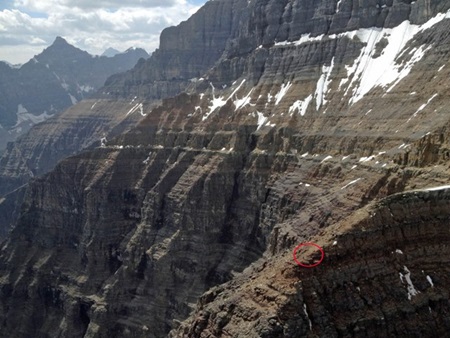
The circle indicates where the climbers where picked up.
Analysis
Occasionally, well prepared climbers fall off. These two climbers were experienced and the East Ridge of Temple was an appropriate undertaking for them. They chose a day with good weather and conditions which also showed that they displayed good judgment. The Rockies are inherently loose and occasionally things happen and people can fall. Despite their bad luck, they were well prepared which facilitated a smooth rescue.
Fall on Snow, Mount Rogers, August 8, 2012, Glacier National Park
Two climbers were ascending the SW Ridge of Mt. Rogers in Glacier National Park, but turned around before reaching the summit due to poor weather. Tracks indicate that rather than descending back down the SW ridge, they exited onto the south face, and were down climbing steep snow above a bergshrund. The climbers were “short roped” together, travelling simultaneously. At approximately 10:00 am, one climber slipped and fell, and the other climber was pulled off. Attempts to self arrest were not successful. They fell approximately 100 meters down slope, coming to rest on the flat lower lip of the bergschrund.
One of the climbers remained unconscious for approximately two hours. When he regained consciousness, he found the other climber to be unresponsive. After half an hour of CPR, the surviving climber descended to his camp in the Hermit Meadows, and called 911 by cell phone.

Mount Rogers accident scene
At 3:45 pm, Parks dispatch received the report of a fallen climber, and initiated a rescue response. A Visitor Safety Specialist flew directly to Hermit Meadows and evacuated the injured reporting person. At that time, the rescuer was able to verify that the climber who remained on Mt. Rogers was deceased. High and variable gusty winds prevented evacuation of the deceased climber that evening. At first light the next morning, two Visitor Safety Specialists flew to the accident site in calm conditions, and evacuated the deceased climber.
Analysis
Short-roping is an advanced skill that takes considerable practise. Climbers must weigh the benefit of moving faster without a belay, versus making anchors and belaying, which can be much slower, and potentially more hazardous due to changing snow and rockfall conditions. Other factors that climbers need to be aware of is softening snow which may cause crampons to “ball up”, making footing more difficult; and travelling above cliffs, bergshrunds or large crevasses, which can act as terrain traps.
Broken Arm, Division Peak, Aug 5, 2012, Banff National Park
As a part of a climbing camp, set up in Icefall Brook, a party of six was traversing Division Peak near the Lyell Icefields. While descending the final peak, a member of the party was hit by rock fall on the arm and sustained a compound fracture. One member of the party continued back to camp to call for rescue by satellite phone, while the four others stay with the injured climber and activated their SPOT device. 
The accident scene, high on Division Peak.
Parks Canada was notified of the incident at approximately 3pm. The Visitor Safety team was already engaged in two other search and rescue operations, so a member of Kananaskis Public Safety was requested to join the Parks Canada rescue leader. The Kananaskis Public Safety member rendezvoused with Parks Canada at Castle Junction by helicopter and the team then continued on to Lake Louise to pick up gear. From Lake Louise they were enroute to the Lyell Icefields. The climbing team was quickly located and the rescue leader formulated a plan. The Parks Canada rescuer slung into the site and relayed back to the other rescuer the equipment needed to accomplish the rescue; the other team member then slung into the site. The patient was packaged quickly and was slung out to staging with the Kananaskis Public Safety member. The four other climbers were subsequently sent out via sling to the staging area, followed by the rescue leader who came last. The uninjured climbers were flown back to their camp because it was very late in the day. The injured climber was flown back to Lake Louise to meet Banff EMS with the rescue team.
Analysis
Rock-fall is common in the Canadian Rockies; therefore careful positioning of climbers and route finding is required. The experience level of the group is unknown; however, it appeared that they dealt with the situation appropriately. They administered first aid and placed a call for help via two different methods to ensure that a rescue was launched.
Rappelling accident, Castle Mountain, Banff National Park, August 4th, 2012
A climber left Calgary on the morning of August 4th. He told his wife that he was going to Castle Mountain. He did not return home that evening. Banff dispatch was contacted the following morning by a friend of the missing climber. The friend reported that the subject was likely going to climb Eisenhower Tower on Castle Mountain, and that he was supposed to have met them on the morning of August 5th to climb something else.
The report was transferred to a Visitor Safety (VS) Specialist, and a trailhead search for the subject’s vehicle was done. His vehicle was located at the Castle lookout Trailhead. This is the standard parking for some routes on Castle, but not for Eisenhower Tower. An aerial, ground and dog search commenced, and VS crews searched the high probability areas throughout the day. The search was called off at dark with no clues regarding the missing person found.
On August 6th, the aerial, ground, and dog search continued. More searchers were called in and an expanded search strategy was developed. Research was conducted on the subjects profile and where he might be expected to go. The subject was a somewhat experienced scrambler, but had just started climbing recently, and had never done a multi-pitch climb. However, his friends described him as a skilled and fearless scrambler who liked to “go straight up to the peak”. He didn’t usually do any research on his objectives, but was usually bold enough to reach the summit, even if off route. His friends said that he knew about Eisenhower tower and really wanted to climb it; however, he had parked in the wrong spot for Eisenhower. He had also left fairly late, and would have been climbing on Castle in the heat of a hot summer day. This information helped VS Specialists form a picture of where the subject may have gone. Still the subject was not found.
In the afternoon of August 7th, the subject was finally located by helicopter on the upper reaches of Castle Mountain (near Bass Buttress). He was in a tight gully feature where it was difficult to see from the air. He was in the vicinity of an established route, but not on it. The subject appeared to have rappelled off the ends of his rope and had fallen about 40 metres. The subject appeared to be deceased. A recovery attempt was made in the afternoon but was aborted due to high winds. 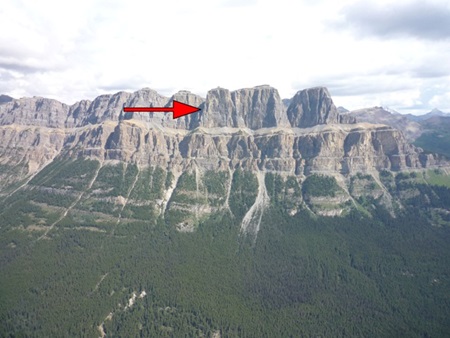
The arrow indicates where the subject was found.
On August 8th, three VS Specialists recovered the body in the early morning via sling rescue. This was a complex operation involving rope work in technical terrain and precision flying. The VS specialists were slung onto a nearby ledge, from where they climbed easy terrain until they were above the deceased. One of the VS specialists was lowered down to the deceased to attach a rope and prepare the body for transport. The helicopter came into the original ledge system, the rope was attached to the rescue line, and the body was slung off using approximately 100 metres of line. This approach was taken because the gully was too tight for the helicopter to fly directly above the accident site. The winds were calm in the early morning which made the operation much safer for everyone involved. 
The helicopter shows the ledge where the VS specialists were dropped off and the rope from the body was hooked to the helicopter. The yellow X shows the location of the anchor. The red circle shows the location of the deceased.
Analysis
This was an extended search and recovery operation for the VS Specialists. All of the highest probability areas were in technical terrain, which made it difficult to use larger groups of untrained searchers. Although much of the terrain could be seen from the air, numerous tight gullies along the cliff face made effective airborne-searching difficult. The subject profile also left it very open as to where he may have gone. Unfortunately, this search did not end with a positive outcome.
VS Specialists pieced together the subject’s approximate itinerary from pictures found on his camera. Amazingly, the subject had summitted Castle by climbing somewhere in the vicinity of Bass Buttress. He may have been on the route, but this is unlikely, and most likely climbed one of the gully features to the summit of Castle. This is an impressive feat, as it would involve 5th class climbing in loose, untraveled terrain without the protection of a rope. The subject decided to rappel the face he had climbed and had made 3 or 4 rappels before he got into trouble. He had no gear to build anchors, he was following off-route anchor stations, and he had no knots in the ends of his rope when he found himself dangling above a steep, sheer wall with little opportunity for natural anchors. He was most likely searching for the next anchor when he rappelled off the ends of his ropes. He fell approximately 40 m into the gully and most likely died on impact. 
The steep wall the subject was rappelling.
This is a sad story, however there are a few lessons we can learn from this:
- Tell someone where you are going and when you expect to return - This is a big one and, although it may not have changed the outcome in this case, the subject would have been found in much less time. This is especially important when climbing alone.
- Carry a communication device – If you have a cell phone and are in cell service, turn the phone on. Rescuers can try to triangulate your location if it is turned on, even if you are not using it. Other options exist for more remote locations such as satellite phones, radios and SPOT type devices.
- Research your objective – Find out where established routes and descents are, what gear to bring, and how long it should take. Sadly, there are multiple established descents off Castle including a walk off, and an easy scramble with a few 30m rappels off bolted stations. These are located within 300m of where the subject perished.
- Get proper training and instruction before heading out on your own – Learn from more experienced people or hire an ACMG guide. If the subject had more experience/ training and had known to tie knots in the ends of his rappel ropes, the outcome may have been different. It was quite a feat to pioneer a new route and descent on Castle solo, and it is unfortunate that it ended with a rappelling accident that could have been avoided by simply tying knots in ends of ropes.
Our condolences go out to the family of the deceased. We hope others can learn from this accident and avoid similar accidents in the future.
Missing hiker, Saskatchewan Crossing, Banff National Park, August 1-2, 2012
A family was visiting the mountains for the first time from metropolitan Europe. Their teenage son, who regularly wandered around the city unsupervised, decided to go for a short hike by himself after dinner. He asked his parents if they wanted to come, but they didn’t, and didn’t think anything of it as it was normal for their son to wander. The teenager stopped at the resort front desk and asked the staff where some short walks nearby might be. The attendant described a few short walks and then watched the teenager depart at around 20:00. He was wearing jeans, running shoes and a t-shirt.
The family started to get worried when their son didn’t return by nightfall. They notified the resort manager, who conducted a quick search of the most likely areas, and then contacted Banff dispatch for further help. Two Visitor Safety (VS) Specialists from Lake Louise, and a Parks search dog team from Banff were dispatched at 12:30 on August 2, 2012. Once more information was gathered, reinforcements were called in from Jasper, with multiple VS personnel and another dog team responding. The weather that night was cool and rainy.
The VS teams searched the high probability areas throughout the night, but clues were difficult to find as the rain had washed most of the scent away. As dawn approached, with no clues found while searching, more reinforcements, including a helicopter were called in from Banff. Shortly thereafter, search teams heard faint calling, and the search dog team quickly zeroed in on the yells. They found the teenager, cold, but otherwise healthy. The helicopter, which was just arriving at Saskatchewan crossing, landed nearby and transported the teenager back to his relieved parents at the resort.
Analysis
The teenager had gone for a walk following a faint trail. The trail disappeared, and he kept going, thinking he was still following something. Once he realized he was no longer on a trail. He could not find his way back. It got dark, and he realized he wouldn’t be able to find the resort that night, so he huddled under a tree to await searchers.
It was a cold and wet night, and the teenager was wearing light cotton clothing. To stay warm and dry, he stuffed his jeans with moss, which he had seen demonstrated on a TV survival show and waited under the umbrella of a tree. These were good ideas, as he was found in good shape, and was much dryer than the properly equipped VS staff who had been searching through wet bush all night. It turned out, he was found approximately one kilometre from the resort in thickly forested, rolling terrain. 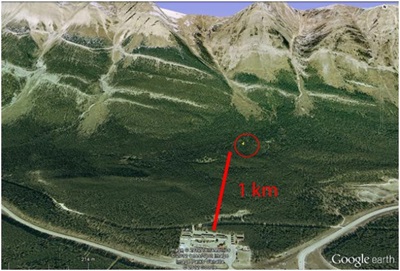
The circle shows the approximate location the teenager was found at.
There is a lot of terrain in the mountains that can be quite confusing, especially if you have no experience in the wilderness. In this case, the teenager was quite confident at route finding in a city, but had little to no experience travelling in the backcountry. He followed a trail which disappeared, as many animal trails do, and couldn’t get his bearings to find his way back. When exploring a new area, it is very important to maintain spatial awareness so that you know which direction to head if you get lost. There are tools such as a map, compass, and GPS which can helps us maintain this spatial awareness in difficult terrain.
In addition, the teenager wasn’t dressed appropriately for the weather. Admittedly, he was only planning on going for a short walk, but this case demonstrates that being prepared with some survival equipment is always a good idea.
Fortunately, the teenager had the good sense to seek shelter and wait for help. This allowed him to stay relatively warm and dry and come out of this experience unscathed.
Stranded Climbers, Tunnel Mountain, Banff National Park, Aug 2, 2012
Two climbers that were relatively inexperienced started late in the day on a route that they thought was Ballista. Ballista is a bolted sport climb on the SE face of Tunnel Mountain. They were climbing very slowly and at one point, one of the climbers took a 10m lead fall but sustained no injuries. They continued to climb up, but eventually it became dark enough that they could climb up no further. They called Banff Dispatch and were transferred to the rescue leader on shift. They tried to describe their position to the rescue leader but some of the details did not immediately add up. However, they were certain they were only one pitch from the top.
Two visitor safety specialists responded by hiking up the backside of Tunnel Mountain with climbing equipment. It took some time to locate the stranded climbers, but a combination of flashing cell phone screens and yelling brought the specialists in line with the climbers. At this point in time the specialists, who are intimately familiar with climbing routes in Banff National Park, discovered they were in fact on a route called Tatonka, which is closer to Gooseberry. After hatching a plan, one specialist was lowered down to the two climbers. The specialist on top hauled the climbers (separately) up to the top, and subsequently the specialist lower down jumared back up. The specialists then accompanied the two climbers to the trailhead.
Analysis
The climbers were unprepared and chose an objective that was beyond their ability. Additionally, the climbers did not have helmets or headlamps for their ascent, both of which are crucial equipment, especially the headlamps if you are starting late in the day. Their inexperience showed in that they did not do enough research on their objective. Climbers are advised to take a proper instructional course from a member of the Association of Canadian Mountain Guides (the only group that is permitted to teach climbing in the National Parks). Climbing and mountaineering is also a slow apprenticeship. It takes time and patience to be able to climb harder and more obscure objectives. Therefore, upping the grade, length and commitment factor in small increments is prudent.
- Date modified :